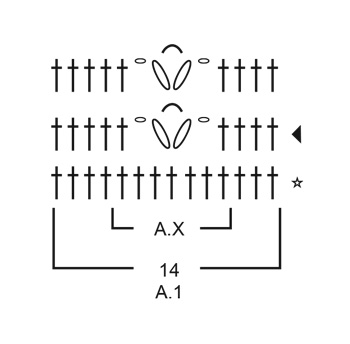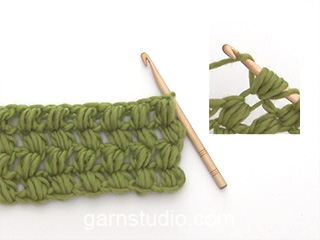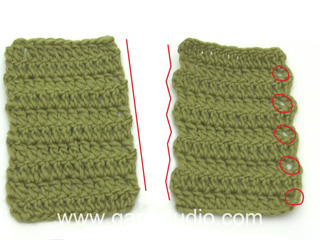Sea Shell |
||||||||||||||||||||||||||||||||||||||||
 |
 |
|||||||||||||||||||||||||||||||||||||||
Crocheted skirt with puff stitches and fan edge. Piece is crocheted top down in DROPS Muskat. Size: S - XXXL
DROPS 202-41 |
||||||||||||||||||||||||||||||||||||||||
|
---------------------------------------------------------- EXPLANATION FOR THE PATTERN: ---------------------------------------------------------- CROCHET INFORMATION: On every row with double crochets replace first double crochet with 1 chain stitch. Finish row with 1 double crochet in chain stitch from beginning of previous row. At beginning of every row with treble crochets replace first treble crochet with 3 chain stitches. Finish row with 1 treble crochet in 3rd chain stitch from beginning of previous row. PATTERN: See diagrams A.1 and A.2. A.X shows puff stitches. When increases begin, increase outside A.X. INCREASE TIP-1 (evenly): To calculate how to increase evenly, use the total number of stitches on row (e.g. 130 stitches) and divide stitches by number of increases to be done (e.g. 10) = 13. In this example increase by working 2 treble crochets in every 13th double crochet. INCREASE TIP-2: Increase 1 treble crochet in every repetition of A.1 by working 2 treble crochets in same treble crochet, but to make the increase nice and less visible do as follows: On first increase in each repetition of A.1 increase in last treble crochet before A.X. On next increase in each repetition of A.1 increase in first treble crochet after A.X. I.e. increase alternately before and after A.X down the skirt. ---------------------------------------------------------- START THE PIECE HERE: ---------------------------------------------------------- SKIRT - SHORT OVERVIEW OF THE PIECE: Piece is worked back and forth, top down until finished measurements. Sew side seam. Finally work an edge at the top of skirt and a button hem along the opening at the top of skirt. SKIRT: Work 156-173-190-212-238-264 chain stitches on hook size 4 mm with Muskat. Work first row as follows: 1 double crochet in 2nd chain stitch from hook, 1 double crochet in each of the next 4-3-2-0-2-4 chain stitches, * skip 1 chain stitch, 1 double crochet in each of the next 5 chain stitches *, work from *-* the entire row = 130-144-158-176-198-220 double crochets. Read CROCHET INFORMATION! Work 1 row with treble crochets (work 1 treble crochet in every double crochet) and increase 10-10-10-20-12-18 treble crochets evenly - read INCREASE TIP-1 = 140-154-168-196-210-238 treble crochets. Work A.1 back and forth (= 10-11-12-14-15-17 repetitions of 14 stitches). Continue pattern like this. AT THE SAME TIME when piece measures 3 cm, increase 1 treble crochet in every repetition - read INCREASE TIP-2. Increase like this alternately before and after A.X every 3 cm 4 times in total and then every 8-8-9-10-10-10 cm 2 times in total = 200-220-240-280-300-340 stitches on row and 20 stitches in every repetition (i.e. there are more treble crochets on each side of A.X when increasing). Work until piece measures approx. 36-38-40-42-44-46 cm (or desired length, approx. 10 cm remain until finished measurements). Adjust so that next row is from right side. Work A.2 back and forth (= 10-11-12-14-15-17 repetitions of 20 stitches). When A.2 has been worked, piece measures approx. 46-48-50-52-54-56 cm on the shortest. Fasten off. ASSEMBLY: Sew skirt together in the side - begin at the bottom and sew edge to edge in outer loop of edge stitch to get a flat seam but stop when approx. 10 cm remain at the top of skirt (work buttonhole straps and button hem here later). Cut and fasten the yarn. EDGE AT THE TOP OF SKIRT: Work 1 double crochet in every chain stitch where double crochets were worked in first row on skirt = 130-144-158-176-198-220 double crochet. Work 2 rows more with double crochets back and forth. Edge measures approx. 2 cm. Cut and fasten the yarn. BUTTONHOLE LOOPS: Along the opening on front piece work buttonhole loops as follows (begin at the bottom): 2 double crochets around a row with treble crochets, 3 chain stitches, skip 1 cm, * work 2 double crochets around next treble crochet row, 3 chain stitches, skip approx. 1 cm *, work from *-* 3 more times and finish with 1 double crochets around each of the last 2 double crochet rows at the top of skirt(= 5 straps for buttonholes). Turn and work as follows: 1 double crochet in every double crochet and 3 double crochet around every chain space. Cut and fasten the yarn. BUTTON FOLDING EDGE: Along the other side of opening work 5 rows with double crochets back and forth (on 1st row work 2 double crochet around every treble crochet row and 1 double crochet around every double crochet row), fasten off. Sew the buttons on to the button folding edge. |
||||||||||||||||||||||||||||||||||||||||
Diagram explanations |
||||||||||||||||||||||||||||||||||||||||
|
||||||||||||||||||||||||||||||||||||||||

|
||||||||||||||||||||||||||||||||||||||||

|
||||||||||||||||||||||||||||||||||||||||

|
||||||||||||||||||||||||||||||||||||||||
|
Have you made this or any other of our designs? Tag your pictures in social media with #dropsdesign so we can see them! Do you need help with this pattern?You'll find tutorial videos, a Comments/Questions area and more by visiting the pattern on garnstudio.com. © 1982-2024 DROPS Design A/S. We reserve all rights. This document, including all its sub-sections, has copyrights. Read more about what you can do with our patterns at the bottom of each pattern on our site. |
||||||||||||||||||||||||||||||||||||||||























































Comments / Questions (8)
Hello, I just started this pattern and I do it in size L. The pattern says to do 12 repetition of 14 stitches but on my 168 stitches the repetitions is more then 12. It came out 15 repetition. I can't find out what I am doing wrong.....?
17.05.2022 - 02:56DROPS Design answered:
Dear Zdenka, A.1 is worked over 14 sts (= 1 dc (US-crochet terminology) in the next 4 sts, skip 2 sts, 1 ch, in the next st work 1 puff st + 2 ch + 1 puff st, 1 ch, skip 2 sts, 1 dc in the next 5 sts (= 4+2+1+2+5=14 sts worked). Happy crocheting!
17.05.2022 - 09:13Bonjour j'adore vos modeles mais houlala les explications pourtant experte impossible de faire un de vos medeles bien dommage....
14.05.2020 - 14:31DROPS Design answered:
Bonjour Mme Tondu, Les modèles DROPS sont réalisés par des milliers de personnes dans le monde entier. Nous comprenons toutefois qu’en fonction du pays, les explications puissent être formulées différemment. Nous faisons naturellement en sorte que nos modèles soient compréhensibles. Vous pouvez volontiers poser votre question ici, et pour toute assistance individuelle, vous adresser à votre magasin DROPS, même par mail ou téléphone. Bon crochet!
14.05.2020 - 14:54Szuper ! ☺Nagyon jól használható minta és méretleirások. Gratulálok, nagyon profi. További sikeres jó munkát kívánok.
19.05.2019 - 12:13It's a beautiful skirt. I will try.
29.04.2019 - 23:01Me gusta su página por todas las cosas hermosas que puede uno hacer y me encanta que den pratrones gratis excelente y felicidades
24.04.2019 - 14:36Me encanta
16.12.2018 - 08:14Muy juvenil
15.12.2018 - 22:16Ilus värv ja ilus seelik.
14.12.2018 - 12:08